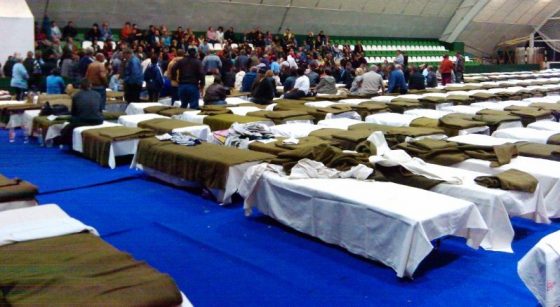
The dangers of going to a disaster shelter or a FEMA camp during an evacuation are many. Because of this, we’ve spent time attempting to encourage everyone to do their best to avoid both at all costs by having back up plans in place. But there’s one more danger of going to a disaster shelter that is perhaps the most disturbing of all: sexual assault.
So just where exactly do sexual offenders go during a hurricane? According to some reports out of Florida, sex offenders in each county are given a designated location that is separate from general population shelters. Most of the sex offenders under state-wide community control are being told they can report to their nearest prison or jail. Officials are also well aware that incidences of rape and assault become much more common in the wake of hurricanes such as Irma and Harvey. When state-wide evacuations for Hurricane Irma began, Florida’s Polk County sheriff announced that sex offenders would be banned from all shelters. “We cannot and we will not have innocent children in a shelter with sexual offenders & predators. Period,” he tweeted.
But what about those who aren’t convicted of a sexual crime but have plans to prey on the women at the shelter? They’ll obviously slip through the cracks and likely be able to hurt a few women without getting caught. there’s just no way to know if someone might be a potential sexual predator. It simply isn’t possible to do a background check on all people who enter a disaster shelter after being evacuated. It isn’t as if those who work at or volunteer at shelters intend to put people in harm’s way, in fact, they just want to help. But there’s no way to police everyone at all times making a sexual assault a horrifying reality of a disaster shelter.
In the aftermath of Hurricane Katrina, which struck New Orleans in 2005, many women came forward to report that they had been raped or sexually assaulted after being evacuated and their stories have been largely unreported. Charmaine Neville spoke to a local television station a few days after Hurricane Katrina hit. But she didn’t really want to talk about the storm much. When she took shelter on the roof of a school, she said, she was raped by a stranger. “I had lain down and gone to sleep and somebody woke me up,” she said in an interview with the TV station WAFB. “They put their hand over my mouth, and a knife to my throat.” Her rapist threatened her, saying: “If you don’t do what I want, I’m gonna kill you and then I’ll do what I want to you anyway and throw your body over the side of the building.”
The horrifying truth is that 80% of teenage girls who survive a sexual assault will also develop a mental illness (such as depression, anxiety, or post-traumatic stress disorder) stemming from the assault about four or five months later. That’s even more reason to keep your daughter and wife away from the creeps we all know are out there.
Overcrowded and understaffed shelters put all those who stay at them at risk, unintentionally. There’s no way a handful of people can monitor hundreds of others at all times, as Neville sadly found out. A disaster can also put people in situations where they’re at greater risk of being assaulted; from living with an abusive family member to staying at a crowded shelter. That’s perhaps the biggest reason to take your safety and shelter into your own hands.
FEMA’s director, Brock Long, has even repeatedly warned that Americans do not have a “culture of preparedness,” and that’s why so many need the shelters at all. To avoid putting children and adolescents (and anyone in your family) in an environment that is dangerous and potentially hazardous is something that is much-needed with the startling uptick in natural disasters. FEMA themselves are telling you not to rely on them and admitting to making mistakes that could have cost people their lives. So how do you prepare for a disaster to avoid a shelter or FEMA camp?
The book The Prepper’s Blueprint offers several suggestions and a step-by-step guide to help. It’s especially essential for those just beginning as a prepper. One of the best action plans for any natural disaster is to have a backup shelter or a place your family can go on their own away from the disturbing infections and diseases of most shelters. You will also be more likely to keep your family safe from sexual predators if you’ve got a means to protect yourself away from the crowds of hungry and angry people fighting over the last can of corn. All family members should also learn some basic self-defense just in case, especially the women. Women should feel empowered, not defenseless. Take classes in your area if you don’t know where to start. It’ll be well worth the money spent. Also, consider employing some simple situational awareness techniques too. Take the time to notice your surroundings and encourage female family members to do the same. Just recognizing that someone may be lurking or following you could save you from an assault. But the simple decision of just being away from the masses and out of sight of others could help you stay safer as well. We continue to advise that you avoid disaster shelters and FEMA camps at all costs.

This article was originally published at Ready Nutrition™ on August 28th, 2018








It appears that you don’t want to consider the many cases of female sexual offenders and their male victims. (Asia Argento comes to mind – and she may evade prosecution).
Why is that?.
that’s not the question…
No – not in a shelter of general population of children, mothers, daughters. These perverts have already demonstrated they cannot be trusted. To handle this contingency, depending on the # of registered offenders int he community allow a separate shelter for them. And, if it doesn’t have the same conveniences/supplies/provisions as the others – tough shit. They should have thought of that. It is the responsibility of leaders to protect our citizens and if that means a lesser accommodation for not just sex offenders but also those convicted of assault and battery. Sorry.
Just like the author, you have chosen to ignore female-on-male and female-on-female offenders…..which endangers those children and the broader society. Self-respecting men (and the relatively few women that honor them) choose to call out this bias and bigotry. .Hopefully you will soon realize that we are all in this mess together.
The dangers of disaster shelters are fema agents taking you to me executed